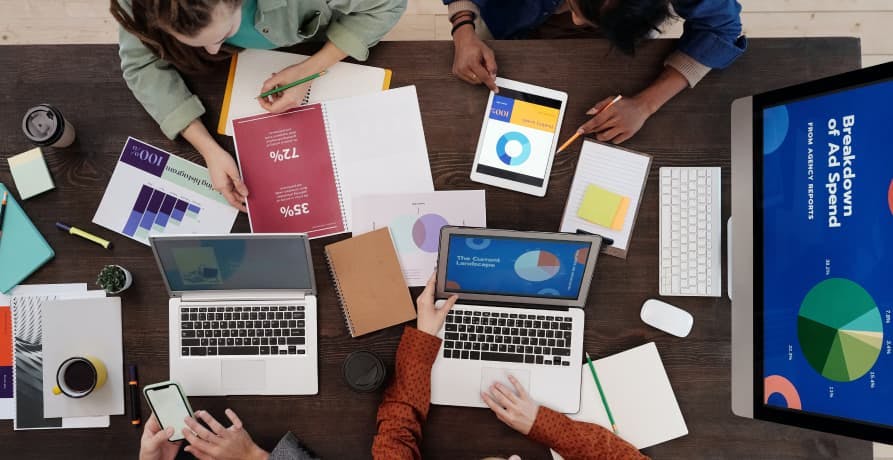
California Climate Accountability Package: SB253, SB261, & SB252
What is the California Climate Accountability Package, and how do SB 253 and SB 261 (SB 219), and SB 252 help the state work towards their environmental goals?
ESG / CSR
Industries



Consumers and regulators alike are putting businesses under increasing pressure to reduce their environmental impact - but where do you even start?
Understanding the carbon footprint of a product, from raw materials to disposal, is a crucial first step. That’s where Product Carbon Footprints (PCFs) come in. By measuring the emissions linked to every stage of a product’s lifecycle, PCFs give businesses the data they need to make informed decisions about sustainability. But how do they work, and why are they quickly becoming essential in today’s market?
In this article, we'll explore what a PCF is, its relevance in today's business environment, and the step-by-step process of conducting one.
You've probably heard the term carbon footprint before (or corporate carbon footprint) - it's a measure of the amount of carbon dioxide (or carbon dioxide equivalent - CO2e) released into the atmosphere as a result of an individual, or company's activities. But you might not have heard the term used in the context of a product - so what exactly is a product carbon footprint (PCF)?
💡 It's worth noting that a PCF is different from a life cycle assessment (LCA). An LCA considers the environmental impacts of a product or service, whereas a PCF is solely focused on the climate impact - ie. the total greenhouse gas emissions associated with a product.
Why is this important? Climate change is the defining issue of our time. Centuries of unabated use of fossil fuels have disrupted the Earth's natural carbon cycle, resulting in a cascade of negative impacts. Global warming is not only upending weather patterns worldwide, it's also making extreme weather much more likely - heatwaves, droughts, flooding, and more intense and extreme storms are sadly becoming part of the norm.
The only way to prevent the situation from worsening further is to cut back on emissions generated. This is why calculating our carbon footprint is so important.


The situation is no different when it comes to products. The products that we consume and buy all have their own carbon footprint, and it's only by calculating these emissions that companies are effectively able to reduce the environmental impact of their products - and ultimately create more sustainable goods and business models.
So what exactly is involved with a PCF? Let's find out…
Calculating a Product Carbon Footprint (PCF) is a structured process that helps businesses understand and reduce the environmental impact of their products. The following steps outline the key actions involved, from setting objectives to communicating results.
| Step | Action | Description |
|---|---|---|
| Step 1 | Establish the PCF objective | Define the goals and objectives of the PCF, considering company values, market demand, regulatory compliance, and efficiency gains. |
| Step 2 | Determine the scope | Determine whether the PCF follows a cradle-to-gate (B2B) or cradle-to-grave (B2C) approach. Select key products based on visibility, environmental impact, and data availability. |
| Step 3 | Create a product process map | Map the product life cycle, including raw materials, manufacturing, distribution, use, and end-of-life disposal. Identify data collection needs. |
| Step 4 | Source the data | Collect primary and secondary data from company records and external sources. Supplement missing data with industry averages and approximations. |
| Step 5 | PCF calculation | Multiply data by emission factors to calculate the product's total carbon footprint, expressed in CO2 equivalents. Consider using third-party experts for accuracy. |
| Step 6 | Analysis and action | Analyze results to identify carbon hotspots and implement reduction strategies such as switching to sustainable materials, improving efficiency, and reducing waste. |
| Step 7 | Communication | Communicate findings to stakeholders through sustainability reports and marketing efforts to enhance transparency and brand differentiation. |
PCFs allow companies to better understand the climate impact of their products by calculating the emissions generated. Generally speaking, this enables organizations to:
However, companies will have their own specific business reasons for undertaking a PCF. Some of the most common motivations include:
A company may want to use PCF results to analyze and ultimately reduce its harmful impacts on the environment.
Consumers increasingly care about sustainability, which is why a PCF can be a useful marketing tool.
Regulatory requirements are increasing with every passing year when it comes to the climate impact of a company.
Inflation is high and everything from the raw materials a company uses to the energy they consume is at an all-time high. PCFs can help companies to identify where efficiencies can be implemented and costs cut.
It's important to set clear goals and boundaries for the PCF. Companies should take into account the business goals and aims, as well as the opinions of staff and stakeholders.

Once the goals of the product carbon footprint have been established, the next step is to determine the scope of the analysis. There are two different approaches for calculating the impact of a product: cradle-to-gate and cradle-to-grave.
Let's take a close look at how they differentiate from one another.
Cradle-to-gate is primarily used for B2B (business-to-business) products. It measures the greenhouse gas emissions stemming from the production of the good (including the extraction of raw materials) and any other emissions associated with the product until it reaches the factory gate.
Cradle-to-grave on the other hand is mainly used for B2C (business-to-consumer) goods. It measures the greenhouse gas emissions for the entirety of the product's life cycle - ie. all stages, including raw material production and distribution, product manufacturing, distribution and retail, product use, and even the disposal and recycling of the product.
Useful criteria for selecting which product to include are considerations such as:
| Criteria | Description |
|---|---|
| Product visibility | Select key products with high sales numbers for which the company is best known. |
| Environmental impact | Identify products likely to have the biggest environmental impact and that would benefit most from a Product Carbon Footprint (PCF) and improvement measures. |
| Availability of data | Choose products based on the availability of appropriate data to accurately and effectively perform the PCF. |

Step 3 is the creation of a process map. A process map is a really useful tool as it enables a company to clearly define the different processes involved in a product's life cycle. It also helps to identify the different data that will need to be collected as part of the PCF.
A typical product process map will include the following considerations:

Data can essentially be split into primary and secondary sources:
Primary refers to data from within the company - which is the easiest to obtain.
Secondary sources are those that lie outside the company - which can often be more challenging to get a hold of. Where a company is unable to get a hold of certain information it may be necessary to supplement data with industry averages and approximations.
Another key distinction is that data can either be based on accounting and records, or physical information gathered. Data based on accounting and records is the easiest information to obtain as a company will be able to consult its own financial records, utility bills, or procurement specifications to obtain this information. Data based on physical information on the other hand can be much trickier as it involves things such as distances travelled, weight of materials, etc.

The carbon footprint calculation can be a complex process. This is because it often involves a whole host of different data sources, each of which will need to be multiplied by specific emissions factors allowing for the calculation of the quantity of greenhouse gas emissions for each activity. The results are summed up to provide a total figure, which is expressed in equivalent units of carbon dioxide, representing the product's overall carbon footprint.
Sounds complicated? Well, that's because it is. The whole process of conducting a PCF is time-consuming and complex. And in order to do it properly, companies need to dedicate time and personnel to the task. This is why many companies choose to employ a third-party expert.
There are various standards that have been created to help quantify the CO2 balance of products and services. The most widely recognized and respected standards include:
Once a company has calculated a product's carbon footprint, the next step is to analyze the results and implement actions that will help the company meet its goals and objectives established in Step 1.
There are many different emissions reduction actions that a company can take following a PCF to improve the sustainability of a certain product.
The list below is non-exhaustive but should give you a bit of an idea as to what these might be:

After all this hard work, it's likely that a company will want to communicate its emissions reductions efforts with stakeholders - this includes employees, customers, clients, suppliers, investors, etc.
Communication of a PCF, the results, and resulting sustainability action help to drive deeper engagement with stakeholders and foster an environment of transparency.
From a marketing perspective, it can also be a highly effective means for increasing a company's customer base, attracting investors, and differentiating the company brand from that of competitors.
The results of the PCF can also be used by a company as part of their sustainability reporting.

However, navigating the intricate process of PCF can be daunting. This is where specialists like Greenly step in, offering expertise to streamline the journey, transforming a complex task into a strategic advantage.
Sustainability is now a requirement for companies across all industries. With rising global expectations to minimize environmental impact and push toward a sustainable future, having the right resources to measure and cut down carbon emissions has become essential.
Greenly provides a suite of sustainability services designed to help businesses take purposeful action towards achieving their environmental goals.
Greenly equips businesses with both expertise and a robust platform to effectively manage their sustainability efforts. From emissions monitoring to strategy development, Greenly guides companies through every stage of their sustainability journey.
Through Greenly’s platform, businesses can monitor their Scope 1, 2, and 3 emissions, gaining an understanding of their environmental footprint and allowing them to identify hotspots. This data serves as a foundation for crafting focused strategies to reduce emissions, align with science-based targets, and meet regulatory obligations.
In addition to emissions tracking, Greenly partners with companies to create sustainability strategies. Our specialists help pinpoint key areas for improvement and provide guidance on actionable plans to reach sustainability objectives.
Reducing Scope 3-related emissions (ie. emissions related to supply chains) poses unique challenges. Greenly’s platform assists companies in identifying and addressing high-emission areas in their supply chains, working collaboratively with suppliers to drive effective and sustainable changes.
Greenly’s intuitive platform streamlines sustainability management, enabling businesses to track emissions, assess progress, and incorporate sustainability into daily operations.
Whether your business is beginning its sustainability efforts or building on current initiatives, Greenly can support you in efficiently managing and reducing your environmental impact.
Ready to move forward sustainably? Let Greenly support your company in taking the next step toward a greener future.
